The Museum Collections
Introduction
I. History and Art Collection
1. Icons of the 14th 19th centuries
icons of the 14th 17th century
2. Jewelry art of the 14th 20th century
jewelry art of the 14th 17th century
jewelry art of the 18th 19th century
the european silver 14th - 19th centuries
3. Small-size sculptures (works of metal, wood, bone)
XI the beginning of the XX century
Small-size sculptures 11th 17th century
Small-size sculptures 18th early 20th century
enamel of Troitza masters 15-8th early 20th century
5.Embroidery, lace, textiles of the 14th - early 20th century
icon and ornamental embroidery
gold and silver lace
6.Painting of the 18th 21st centuries
painting of the 18th 19th centuris
painting of the 20th 21st centuris
II.Manuscripts and old printed books of the 14th 17th century
IV.Lithography of the 18th 19th century
V.Numismatics
VI.Medals of the 18th - early 20th century
VIII.Archeology collection
IX. Russian folk and applied and decorative art of the 17th 21st c.
1. Artistic wood
folk carved and painted wood
wooden toys
house carving of Sergiev Posad
Khokhloma and Gorodets painting
2. Artistic textiles
embroidery and weaving
printed textiles and lace
Russian shawls
folk costumes
folk garments
printed cotton kerchiefs
|
Jewelry Art of the 14th 17th cc. (page 1)
|
The collection of jewelry art of the Sergiev Posad Museum gives a comprehensive idea of high skill of Russian craftsmen. The main part of the collection includes donations. They were usually church utensils, commissioned for the Monastery, or family relics ( silver vessels mainly) blessed by the ancestors and patrimonial legends of princes, boyars and servicemen.
The most valuable part of the collection presents works of early Moscow period of the 14th century. They show popular techniques and, at the same time, they illustrate the character of fine art of that time as nearly all of them are decorated by pictorial images. Among them is a rare silver chalice of the first half of the 14th century, presumably donated by boyar Dmitry Ivanovich Godunov.
Engraving was characteristic of Moscow art of the mid-14th century. It was sometimes combined with niello. These techniques were used for decoration of the cross-reliquary made by Semyon Zolotilov, a craftsman of Prince Dmitry Donskoi. On the sides of the cross the thick nielloed contour laid between two engraved lines depicts the saints: on the obverse St. Georg and St. Demetrius (on the top and on the bottom), the Apostles Peter and Paul or SS. Cosmus and Damian (on the sides), on the reverse the Virgin and St. John the Theologian (on the face planes of the sides), St. John Chrysostom and St. John the Baptist (on the top and the bottom), cherubs and saints (St. Nicholas with raised hands is recognized between them) in the circles and in the central part.
Apart from Moscow works the Museum collection presents early Novgorod items decorated with filigree, engraving, casting, enamel. Round plaques of the last quarter of the 14th century, decorating the epitrachelion, are of special interest. They are decorated with chamfer enamel, the information of which has not survived.
|

Chalice. First half of the 14th century. Donated by Dmitry Ivanovich Godunov |
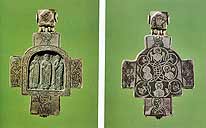
Cross-reliquary. The Crucifixion, Archdeacon Stephen, St. Nicholas, St. Stephen the Confessor(?). Mid-14th century. Work of Semyon Zolotilov. Obverse & Reverse |
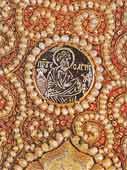
Plaque. The Apostle Peter. 14th century. Novgorod. Detail of the 17th century epitrachelion
|
Works of Moscow gold- and silversmiths of the 15th century in the Museum collection testify to the variety of shapes and perfect command of many techniques. Andrei Rublev style shows in the gilded engraved deesis depicting seven half-length images ( Christ, the Virgin, St. John the Baptist, Archangels Gabriel and Michael, Apostles Peter and Paul) on the bowl of the silver chalice of the first half of the 15th century, probably made by a Trinity craftsman.
Real masterpieces of jewelry art are the cross-reliquary with the Crucifixion the Virgin Orans and the Trinity and panagia with the Savior Enthroned and St. Nicholas on the exterior parts, the Virgin of the Sign and the Trinity, repeating Rublev iconography,
inside.
|
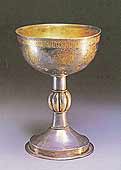
Chalice. 1420s. |
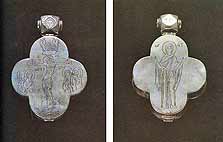
Cross-reliquary. The Crucifixion and the Virgin Orans. Late 15th century. Obverse.Reverse |

Reliquary. Apostles St.Peter and St.Paul. 1463. The Trinity Monastery (?) |
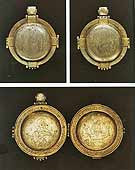
Panagia. Christ Enthroned, the Virgin of the Sign, the Old Testament Trinity, St. Nicholas. Late 15th century. Obverse. Reverse. Interior
|
Works of Moscow gold- and silversmiths of the 15th century in the Museum collection testify to the variety of shapes and perfect command of many techniques. Andrei Rublev style shows in the gilded engraved deesis depicting seven half-length images ( Christ, the Virgin, St. John the Baptist, Archangels Gabriel and Michael, Apostles Peter and Paul) on the bowl of the silver chalice of the first half of the 15th century, probably made by a Trinity craftsman.
The Trinity silversmiths, casters in particular, quickly sensed its achievements. In the first quarter of the 15th century one of the Monastery craftsman possibly made the panagia that belonged to the Monastery hegumen Nikon. The precious Gospel cover of the late 15th century, originating from the Nikilo-Pesnoshsky Monastery, was very likely connected with the Trinity artistic workshops.
|
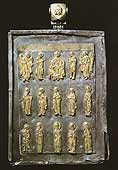
Reliquary. The Deesis and Saints. 1410 1429. Belonged to Radonezh Princes |
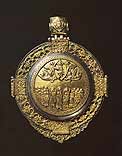
Panagia. First quarter of the 15th century. Obverse. Belonged to Father Superior Nikon |
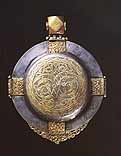
Panagia. First quarter of the 15th century. Reverse. Belonged to Father Superior Nikon |
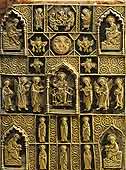
Gospel. Late 15th century. Originally from the Nikolo-Pesnoshsky Monastery
|
|


